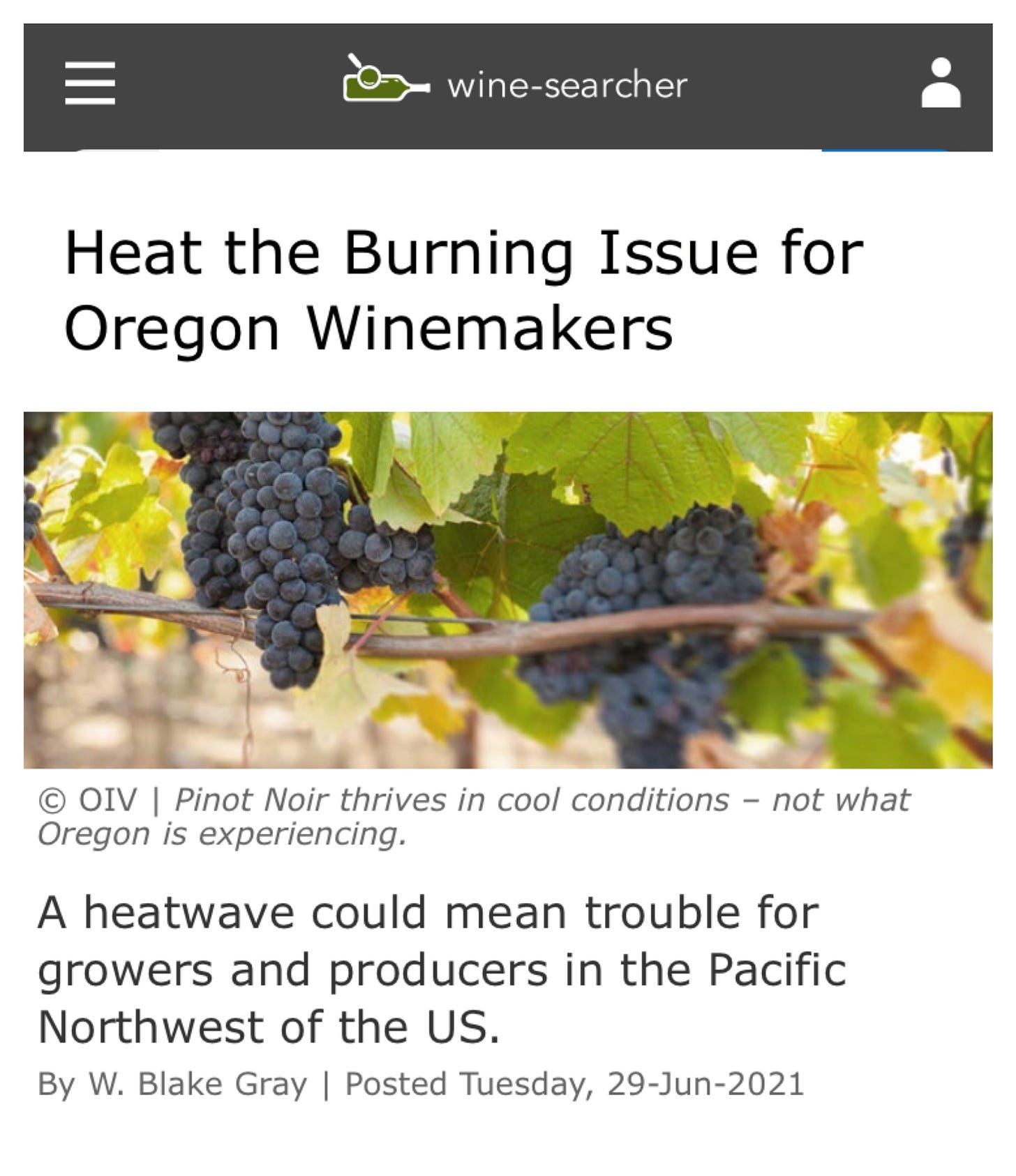Weather and Wine
It’s The Heat. With the Pacific Northwest and parts of western Canada dealing with an unprecedented heat wave, Wine-Searcher wrote about the Burning Issue for Oregon Winemakers. Oregon is home to nearly 800 wineries, and is known for its Pinot Noir, which grows well in its normally cool climate. But Oregon’s Willamette Valley had its hottest day in recorded history this week, with temps reaching 117 degrees. Warmer weather typically causes grapes to ripen faster, leading to lower acidity, and higher levels of sugar and alcohol. Research climatologist Gregory Jones says there have always been heat waves, but it’s their scale that shows the impact of climate change. But Jason Lett of The Eyrie Vineyards believes the vines will get through the heat, saying that vinifera “evolved on volcanic sunbaked slopes in much more hostile environments than the Willamette Valley.” An Oregon low-intervention winemaker to look out for is Joe Swick (imported in Ontario by Keep6 Imports), who makes wines that he himself would like to drink — fresh, lively acidity, with no conventional additives, available at Birreria Volo and other TO Bottle Shops. Other Oregon winemakers I’d like try include The Marigny, Hiyu Wine Farm, and Bow & Arrow, to name a few.
Sustainable Wine Packaging. Bon Appetit's Healthyish wrote that “When we think about sustainable wine, we tend to consider growing practices” — which is something this newsletter tries to focus on (organic! biodynamic! environmental! preservation!) — but we overlook “the container our wine comes in.” Their article highlights some of the packaging changes wineries have made including:
Using wax seals instead of foil capsules;
Reducing bottle weight;
Labels made of recycled materials and water or soy-based inks;
Switching from foreign to domestic glass bottle suppliers;
Single-serve canned options made from recyclable aluminum; and
Using recyclable and biodegradable materials for shipping.
These are just a few of the changes being made to improve the sustainability of bottling and shipping wine, but there are other opportunities. Special thanks to Kari at Drink Better who took the time to share a lot of helpful info with me on this issue. Kari made the important point that Reduce is the first of the 3Rs that needs to be focused on, questioning the need for capsules, which is one of the methods used for tamper-proof closures, a mandatory requirement from LCBO’s Product Packaging Standards.
Reusable and Paper-Based Wine Bottles. The NYT’s Eric Asimov wrote about companies experimenting with alternatives to glass, including Gotham Project who specializes in kegged wine. Apparently only about 30% of glass bottles are recycled in the U.S., with over 3 billion being landfilled each year. Gotham’s founder, Bruce Schneider, estimates “that by selling wine in reusable stainless steel kegs… Gotham has eliminated more than 5 million single-use glass bottles from being tossed.” And Good Goods is a reusable bottle start-up in NY, whose website says: “Before mass industrialization, wine makers would use the same vessels over and over again out of common sense and necessity. Consumption doesn’t have to equate to waste.” To incent consumers to return the bottles, Good Goods offer a store credit instead of a bottle deposit, which has seen compliance rise to 85%. Meanwhile, an English winemaker has started selling its wine in paper bottles. “The Frugal Bottle” is manufactured by Frugalpac in the UK, and made from 94% recycled paperboard; it’s said to be 5x lighter than glass, with an 84% lower carbon footprint.
Climate Change and Wine. In 2019, Eric Asimov published a four-part series on winemaking and climate change which is worth a re-read during a time when it’s warmer in parts of western Canada than in Dubai. At the time, Asimov wrote about how “the accelerating effects of climate change are forcing the wine industry, especially those who see wine as an agricultural product rather than an industrial beverage, to take decisive steps to counter or adapt to the shifts.” In a Q&A with Asimov, he encouraged people to “start asking more questions about where their wine comes from, how it’s made, how the grapes are grown and how the producers take climate change into account in their production — and make their feelings known through their buying decisions.”







